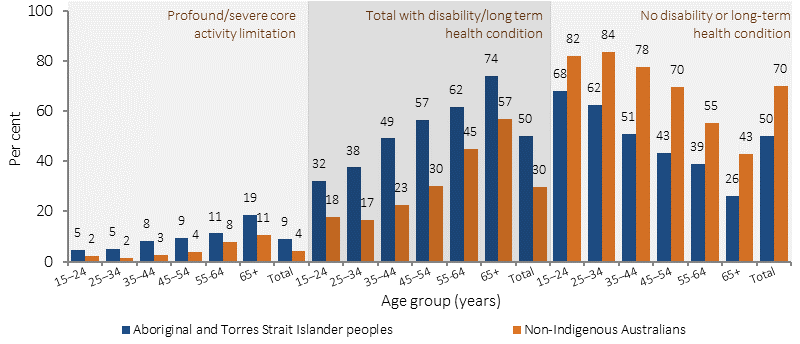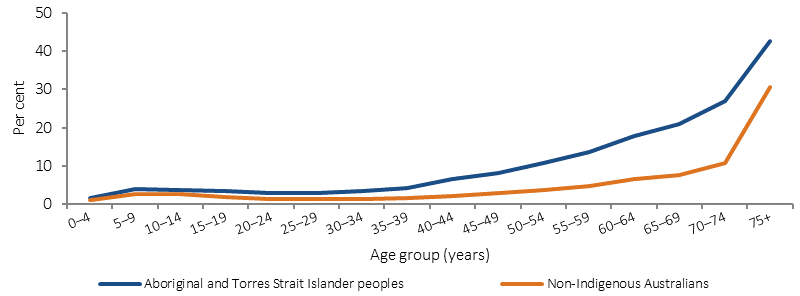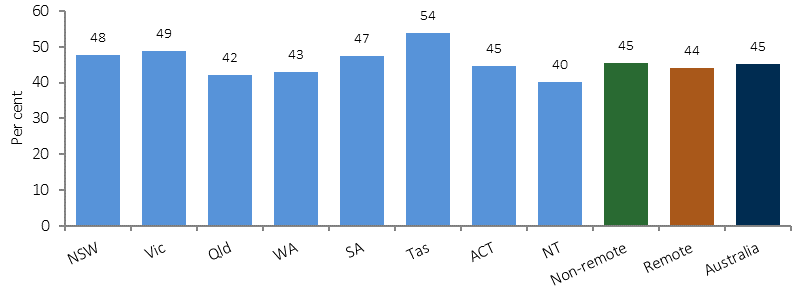1.14 Disability
Page content
Why is it important?
Disability may be an impairment of body structure or function, a limitation in activities and/or a restriction in a person’s participation in specific activities. A person’s functioning involves an interaction between health conditions and environmental and personal factors. Aboriginal and Torres Strait Islander peoples are at greater risk of disability due to increased exposure to factors such as low birthweight, chronic disease, infectious diseases (e.g. otitis media), injury and substance use. Along with limited access to early treatment and rehabilitation services, these factors increase the risk of a person acquiring a disability. Such factors tend to be more prevalent in populations where there are higher rates of unemployment, lower levels of income, poorer diet and living conditions, and poorer access to adequate health care.
Findings
The 2014–15 Social Survey collected data for those aged 15 years and over on a broad definition of disability (i.e. those reporting a limitation, restriction, impairment, disease or disorder that has lasted, or is expected to last, for 6 months or more, which restricts everyday activities) (ABS, 2016e). Results are self-reported and therefore could be under-stated. In 2014–15, 45% of Indigenous Australians aged 15 years and over had a disability or restrictive long-term health condition. There has been a decline in this rate since 2008 (down 5 percentage points from 50%). Disability increases with age, ranging from 32% of those aged 15–24 years to 74% of those aged 65 years and over.
Around 8% of Indigenous Australians aged 15 years and over had a profound or severe core activity limitation with at least one activity of everyday living (self-care, mobility or communication). A further 6% reported a moderate core activity limitation and 9% a mild limitation. Schooling/employment restrictions only were reported by a further 6% of Indigenous Australians. Thirty-seven per cent of Indigenous students aged 15–64 years with a disability reported difficulty with pursuing their education. Difficulties with employment were reported by 42% of Indigenous Australians aged 15–64 with a disability.
Indigenous females aged 15 years and over had a higher rate of disability (47%) than Indigenous males (43%). Of those with a disability, 64% had physical disabilities, 47% sight/hearing/speech disabilities, 19% psychological and 18% intellectual disabilities. Variations in self-reported responses by jurisdiction and remoteness may be affected by factors such as perceptions of health and access to health care for diagnosis. Self-reported rates of disability or restrictive long-term health conditions were lowest in the NT (40%) and highest in Tasmania (54%). Rates were similar in remote areas (44%) and non-remote areas (45%).
In 2014–15, after adjusting for differences in the age structure of the two populations, Indigenous Australians aged 15 years and over were 1.7 times as likely to have a disability or restrictive long-term health condition as non-Indigenous Australians, and 2.1 times as likely to have a profound/severe core activity limitation. Indigenous disability rates are higher than non-Indigenous rates for all age-groups, and particularly higher in the younger years. More than half (52%) of Indigenous Australians aged 15 years and over reporting disability were not in the labour force, compared with 33% of those without. Indigenous Australians with a disability were also more likely than those without a disability to be living in households in the lowest income quintile (43% compared with 33%) and to have had problems accessing services (29% compared with 20%).
The 2012–13 Health Survey results included data on disability and restrictive health conditions for all age groups. In 2012–13, 36% of all Indigenous Australians had a disability or restrictive long-term condition.
The 2011 Census collected data on one element of disability (i.e. those reporting the need for assistance with core activities). In the 2011 Census, 5.7% of the total Indigenous population were identified as needing assistance with a core activity (self-care, mobility or communication) some or all of the time. Rates were similar for males (6.1%) and females (5.4%). Variations in self-reported rates by jurisdiction and remoteness should be treated with caution. Rates ranged from 4.5% of Indigenous Australians in the NT to 6.9% in Victoria. In 2011, Indigenous Australians were twice as likely to have a core activity need for assistance as non-Indigenous Australians. ACT had the largest gap followed by WA. The proportion of Indigenous Australians with a core activity need for assistance was higher in all age groups; however, rates increased from 40 years on for Indigenous Australians and from around 60 years for non-Indigenous Australians. In 2011, 13% of Indigenous Australians aged 15 years and over provided unpaid care to a person with a disability, long-term illness or problems related to old age, 1.2 times the non-Indigenous proportion. Carers were less likely to be in the labour force (54%) than non-carers (59%).
In 2014–15, 19,000, or 5.9% of disability support service users under the National Disability Agreement were Indigenous (AIHW, 2016aa). In 2014–15, there were 118 Indigenous Australians who transitioned from the disability support services to the National Disability Insurance Scheme (NDIS) (out of 1,900 who transitioned that year). For persons aged under 65 years, Indigenous Australians used disability support services at twice the rate of non-Indigenous Australians (28 per 1,000 compared with 15 per 1,000). Rates of Indigenous service users were highest in Victoria (50 per 1,000) and lowest in Tasmania (17 per 1,000). Rates were higher in non-remote areas (30 per 1,000) than remote areas (16 per 1,000). Intellectual disability was the most common primary disability group for Indigenous service users (27%), followed by physical (18%) and psychiatric disability (18%). Most commonly used were community support services (54%), followed by employment services (36%). The disability support pension was the main income source for Indigenous and non-Indigenous service users (59% and 58% respectively).
Figures
Figure 1.14-1
Disability status for those aged 15 years and over by Indigenous status and age group, 2014–15(a)

(a) Totals are age-standardised.
Source: ABS and AIHW analysis of 2014–15 NATSISS
Table 1.14-1
Disability type, by age group for those aged 15 years and over, Aboriginal and Torres Strait Islander peoples 2014–15
| Disability type | 15–24 | 25–34 | 35–44 | 45–54 | 55–64 | 65+ | Total |
|---|---|---|---|---|---|---|---|
| Per cent | |||||||
| Sight, hearing, speech | 44 | 35 | 39 | 55 | 58 | 64 | 47 |
| Physical | 41 | 65 | 70 | 71 | 74 | 72 | 64 |
| Intellectual | 30 | 15 | 19 | 15 | 9 | 12 | 18 |
| Psychological | 20 | 23 | 24 | 18 | 17 | 9 | 19 |
| Head injury, stroke or brain damage | 1 | 2 | 3 | 5 | 4 | 5 | 3 |
| Other | 16 | 24 | 31 | 32 | 42 | 34 | 28 |
| Total with a disability or long-term health condition (a) | 100 | 100 | 100 | 100 | 100 | 100 | 100 |
(a) Note that more than one disability type may be reported and thus the sum of the components may add to more than the total.
Source: ABS and AIHW analysis of 2014–15 NATSISS
Figure 1.14-2
Proportion of persons with core activity need for assistance, by Indigenous status and age group, 2011

Source: ABS and AIHW analysis of 2011 Census data
Figure 1.14-3
Proportion of Aboriginal and Torres Strait Islander peoples aged 15 years and over, with disability/long-term restrictive condition, by jurisdiction and remoteness, 2014–15

Source: ABS and AIHW analysis of 2014–15 NATSISS
Implications
Although disability prevalence varies across data sources, all show a higher rate of disability experienced by Indigenous Australians compared with non-Indigenous Australians. The high levels of disability and earlier onset of core activity restrictions experienced by Indigenous Australians are consistent with the levels of disease and injury, socio-economic and environmental factors, health risk factors and lower access to health services relative to need. There is a clear link between disability and socio-economic disadvantage and the relationship between these factors is cyclical (Kavanagh et al, 2013; VicHealth, 2012). Lower levels of educational attainment, participation in the workforce and lower income are likely to be both the cause and consequence of disability (Biddle, 2013).
The National Disability Strategy 2010–2020 provides a 10 year national policy framework for all levels of government to improve the lives of people with disability. The Strategy seeks to drive a more inclusive approach to the design of policies, programmes and infrastructure so that people with a disability can participate in all areas of Australian life. A new plan for improving outcomes for Indigenous Australians with disability will be incorporated as a component of the Strategy’s second implementation plan.
The Indigenous plan will include areas for future focus and will consist of activities across both specialist and mainstream policy areas such as education, employment, health and the National Disability Insurance Scheme (NDIS). Through the National Disability Agreement, all Australian governments developed a National Indigenous Access Framework, which aims to ensure the needs of Indigenous Australians with disability are addressed through appropriate service delivery arrangements. As at June 2016, 6% of those with approved plans under the NDIS were Indigenous (1,831 people)(NDIA, 2016).
The NDIS is being gradually implemented across Australia, with trial sites since July 2013. The NDIS provides funding for long-term, individualised care and support to meet the needs of people with permanent disability, where a person’s disability significantly affects their communication, mobility, self-care or self-management. The NDIS will be progressively rolled out from 1 July 2016, and full rollout is expected to be completed by 2019. Once the scheme is fully rolled out, it will provide support for about 460,000 people who have a significant and permanent disability.